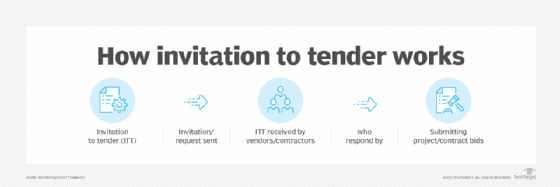invitation to tender (ITT)
What is an invitation to tender (ITT)?
An invitation to tender (ITT) is a formal document that is issued by a company or an organization inviting suppliers or contractors to submit a bid for a project or service.
This process, a legal obligation in many countries, is part of the procurement cycle and is commonly used in public sectors such as construction, large-scale manufacturing, information technology and government projects.
The goal of an ITT is to ensure fair and open competition for the contract, allowing the issuing organization to compare different providers and select the one that offers the best value for money.
An ITT document specifies all requirements of the organization, including goods, services and timelines, as well as the evaluation process that will be followed.
The ITT document usually includes the following:
- Project overview.
- Technical requirements.
- Tendering procedure.
- Selection criteria.
- Terms and conditions.

What is the benefit of an invitation to tender in public procurement?
ITTs play a pivotal role in the public procurement of goods, services or works by government bodies or public sector organizations. Here is more information on the key benefits of an ITT.
Ensuring fair competition
The ITT process ensures all interested and eligible suppliers have an equal opportunity to compete for a contract. By publicly announcing the tender, the public body provides equal access to information about the contract, which can lead to more competitive bids and better value for public money.
Transparency and accountability
Public procurement is subject to high levels of scrutiny due to the use of public funds. The ITT process provides a clear, transparent method for awarding contracts, which demonstrates that the organization is acting responsibly and making decisions that offer the best value.
Compliance with regulations
Public sector organizations are usually required to comply with regulations and laws regarding procurement. These rules often mandate the use of a formal ITT process for contracts above a certain value. By following an ITT process, public bodies can ensure they are meeting these legal requirements.
Value for money
The competitive nature of the ITT process encourages suppliers to submit their best proposals in terms of cost, quality and delivery, letting the public entity get the best value for the money.
Standardization and efficiency
The ITT process allows public entities to compare different bids in a standardized manner. Each bidder must provide information in a similar format, following the same rules. This makes the evaluation process efficient and fair.
Risk management
The ITT process allows for a comprehensive assessment of potential suppliers, which can reduce risks. It includes steps for checking suppliers' financial stability, past performance and technical capacity, which can help public bodies avoid potential issues during the execution of the contract.
What is required for a vendor to participate in an ITT?
In an open ITT, any vendor who can provide a guarantee of performance may offer. In closed ITTs, vendors may have been preselected, screened or qualified by an expression of interest to generate a shortlist of eligible candidates.
The specific requirements for submitting a response to an ITT can vary depending on the specific project, the industry and the organization issuing the ITT. However, some common elements typically required in a tender submission include the following:
- Company profile. Detailed information about the company, including its history, size, team and relevant experience. This may include a list of past projects like the one being tendered.
- Technical proposal. A direct response to the project requirements laid out in the ITT. It should explain how a vendor plans to meet these requirements, detailing its proposed approach, methodology or solution.
- Financial proposal. Estimated costs for the proposed solution. It is crucial that the financial proposal is transparent, comprehensive and offers good value for money.
- Proof of financial stability. Proof of financial stability to ensure the vendor has the resources necessary to fulfill the contract. This could be in the form of financial statements, bank references or audited accounts.
- Legal documentation. Business licenses, insurances, tax registration and other legal documents relevant to the company's operations.
- References. Contact information for clients who can vouch for the company's reliability, professionalism and quality of work.
- Quality assurance. Details of the vendor's quality management systems and processes as well as any relevant certifications (like ISO standards) if applicable.
- Health and safety. If relevant, demonstrations of compliance with health and safety regulations, including any relevant policies and procedures the company follows.
- Ethics and compliance. Evidence of the company's commitment to ethical business practices, such as an anti-bribery or corruption policy.
What is the outlook for ITT?
The future of ITT is significantly influenced by the digital transformation happening across industries, with e-tendering becoming an increasingly popular method for managing the tendering process.
E-tendering platforms are becoming more widely used to manage the entire tendering process, from the issuing of the ITT to the submission and evaluation of tenders. These platforms streamline the process and make it more transparent and accessible.
Additionally, digital platforms simplify access to ITTs for businesses of all sizes, including small and medium enterprises. This helps increase competition and diversity in the bidding process.
E-tendering platforms gather and analyze data from the tendering process in real-time, providing valuable insights for procurement professionals. This can aid in strategic decision-making and help improve future procurement processes.
The move towards digital ITT processes can also contribute to sustainability by reducing the need for physical documents and travel, thereby lowering the carbon footprint of the tendering process. However, as with all digitization, cybersecurity to protect sensitive data and maintain integrity will be paramount.
Learn about 5 big digital transformation trends. Explore 14 need-to-know tips for digital transformation success and 6 tips for digital transformation budget planning.
